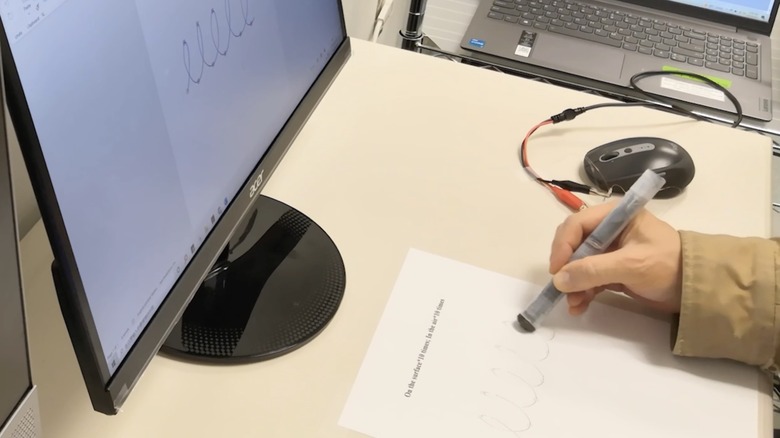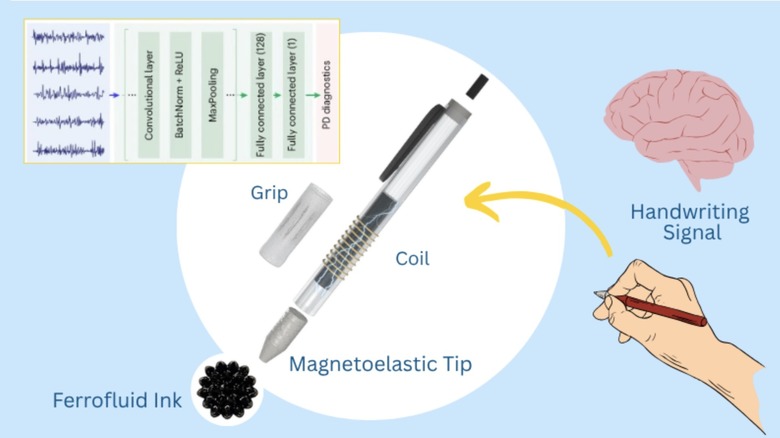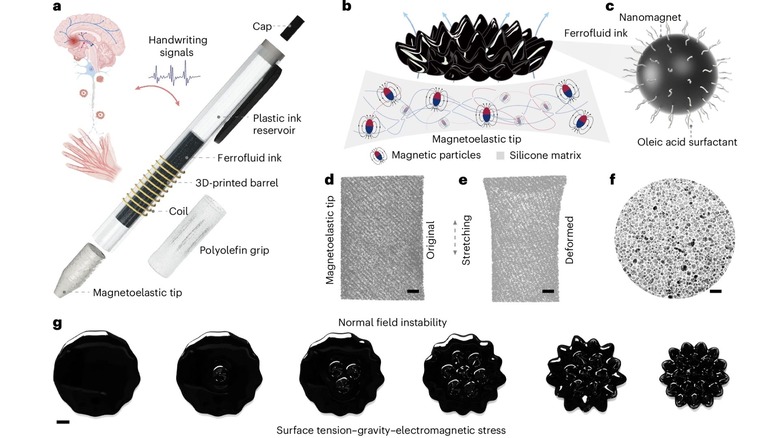How A Cheap, 3D-Printed Pen May Be Able To Help Diagnose Parkinson's Early
In the U.S., there are approximately a million people living with Parkinson's disease, a nervous system disorder that seriously affects body movements, often characterized by tremors. There is no definitive cure for it, but there are medicines that can help control the symptoms. The best route, per experts, is early diagnosis and timely intervention. Diagnosis of Parkinson's is usually done by a healthcare expert, requiring physical and neurological examinations. That's not always feasible, or it's restrictive in terms of the costs involved.
The folks over at the UCLA Henry Samueli School of Engineering and Applied Science have come up with a rather novel — and affordable — solution that promises to detect early signs of motor issues using a specialized 3D-printed pen. The magnetoelastic pen, as the researchers are calling it, "could help detect early signs of Parkinson's by analyzing a person's handwriting." The tip of the pen is made of a special silicon magnetoelastic material, and the ink is also magnetic in nature.
Think of magnetic liquid ink that was once seen as the future of gadgets, or the dark ferrofluid ink in lamps. The most notable aspect of this pen is that it can convert the movements made on a solid surface, and even those in the air, into digital signals that are analyzed by healthcare experts. As part of the pilot test study that involved 16 human volunteers, the smart pen was able to distinguish between healthy individuals and Parkinson's patients with an impressive 96.22% accuracy.
How it works?
"Our diagnostic pen presents an affordable, reliable and accessible tool that is sensitive enough to pick up subtle movements and can be used across large populations and in resource-limited areas," Jun Chen, co-author of the research paper published in the Nature Journal, was quoted as saying. But why handwriting?
Writing is a sophisticated mix of perceptual, cognitive, and motor abilities, all of which receive a big setback from Parkinson's-related nervous damage. In its current implementation, writing-based tests that involve tablets and medical pens predominantly trace the writing trajectory, and not the motor signals that are generated during the process of writing. That's the crucial problem solved by the team's 3D-printed pen, as it analyzes both on-surface and in-air writing motions.
Additionally, the team notes that the self-powered pen offers a "low-cost, widely disseminable, reliable and accessible strategy" for diagnosis of Parkinson's Disease, especially when it comes to early detection in large population groups where medical expenses are a key hurdle. As far as the pen goes, it features a replaceable ink reservoir, while the main body is made of low-cost materials.
So, how does it work? When the pen is waved in the air (mimicking handwriting), the movement of the magnetic ink in the chamber is recorded as acceleration data. When it is being used to sketch or write on a surface, the pressure differential generated in the soft tip, as well as the net writing pattern, is analyzed collectively as part of the diagnosis routine.
How can it solve the Parkinson's problem?
Now, there are multiple "convenient" solutions that aim to detect the subtle signs of Parkinson's in the early stages. Among them is KeySense, which relies on the pattern of keystroke cadence and rhythm. Last year, a paper published in the IEEE Journal of Translational Engineering in Health and Medicine mentioned a software-based technique called NeuroDiag that relied on drawing and writing tasks to look for risk factors. In fact, handwriting analysis has appeared in multiple research papers to discover graphomotor impairment in patients, some of which rely on AI algorithms to pick up signals of motor issues.
There are even online tests that test motor performance using finger gestures performed in front of a camera. In this case, the 3D-printed pen with magnetic ink allows the collection of high-fidelity signals that focus on motor signals as much as it does on surface-based motion data collection. This approach makes it a more complete solution compared to the traditional methods described above. "By concentrating on motor actions rather than the resultant handwriting outcomes, our technology avoids any potential biases of chirography analysis, offering a potentially more symptom-oriented evaluation," the team writes in the research paper.
Moreover, it is user-friendly and does not involve the collection of user-identifiable data, which adds to its privacy-first appeal. Another crucial benefit is that it can help identify Parkinson's symptoms in people who have remained undiagnosed because of symptoms that have gone unrecognized so far. The team is now focused on widening the test pool for a larger study and using it to identify patients at varied stages.


